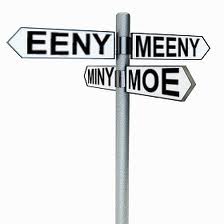

In the canonical Eeny Meeny, “tiger” is standard in the second line, but this is a relatively recent revision. And I’d be remiss in omitting “One potato, two potato, three potato, four / Five potato, six potato, seven potato, more,” which flirts with replacing eeny meeny as the counting-out gold standard in the United States. “Ippetty, sipetty, ippetty sap, ipetty, sipetty, kinella kinack” (Scotland). “Eenty, teenty, ithery, bithery” (England). “Hinty, minty, cuty, corn, wire, briar, limber lock” (United States).

Not only are there hoards of Eeny Meenies, there are just as many counting-out schemes that share the same DNA. In the fifties and sixties, the formidable husband-and-wife folklorists Iona and Peter Opie recorded hundreds of varieties in England and America, including, to name just a few: What we do know is that once Eeny Meeny appeared on the scene, it was everywhere. But where did eeny meeny come from? Kipling tells us that “Eenee, Meenee, Mainee, and Mo / Were the First Big Four of the Long Ago,” but that’s not such a good lead. It turns up in strange places: in Pulp Fiction, in the Great Vermont Corn Maze, in Justin Bieber songs. No one knows what eeny or meeny might mean everybody knows what “eeny meeny” means.

“Eeny meeny miny mo” is one of those rhymes that’s ingrained in our cultural limbic system-once we hear the first two syllables, the rest unspools whether we want it to or not. A Works Progress Administration poster for the Cedar Central Apartments in Cleveland, Ohio, ca.


 0 kommentar(er)
0 kommentar(er)
